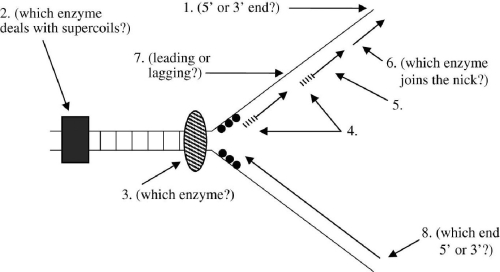The accompanying figure diagrams DNA replication as currently believed to occur in E. coli. From specific points, arrows lead to numbers. Answer the questions relating to the locations specified by the numbers.
(1) Which end (5′ or 3′) of the molecule is here?
(2) Which enzyme is probably functioning here to deal with supercoils in the DNA?
(3) Which enzyme is probably functioning here to unwind the DNA?
(4) Which nucleic acid is probably depicted here?
(5) What are these short DNA fragments usually called?
(6) Which enzyme probably functions here to couple these two newly synthesized fragments of DNA?
(7) Is this strand the leading or lagging strand?
(8) Which end (5′ or 3′) of the molecule is here? 
Definitions:
Internal Values
Core beliefs or principles that guide an individual's behavior and decision-making from within.
Influence Processes
The various methods and strategies through which individuals affect the thoughts, behaviors, and feelings of others.
Follower Characteristics
The attributes or qualities of individuals who are led, which can affect the leadership process and outcomes.
Political Conflicts
Disputes arising from differences in opinions, beliefs, or interests within a political context.
Q3: An individual with Klinefelter syndrome generally has
Q5: What are histones, and how are they
Q8: The nucleolus organizer (NOR) is responsible for
Q8: Describe the mutagenic action of the following
Q21: Restriction endonucleases typically recognize palindromic DNA sequences
Q24: (a) Describe by labeled diagram the structural
Q27: Caenorhabditis elegans is extremely useful as an
Q37: Certain base analogs such as 5-bromouracil cause
Q44: What are the roles of the recBCD
Q50: Which of the following contains the three